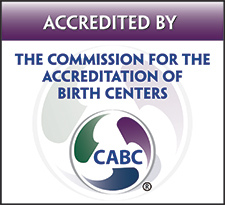Gestational diabetes is one of the most common prenatal complications affecting five to ten percent of pregnancies. Most people know someone who has been affected, and many pregnant people have questions about how they can get tested for gestational diabetes, what a diagnosis means, and how it might impact their plans for a community birth. We’ll answer any questions you may have in our blog this week.
What is Gestational Diabetes?
I admit, this topic has been on my mind recently since my own gestational diabetes screening is coming up this month. So what exactly is gestational diabetes? It’s all about hormones! Insulin is a hormone made by the pancreas that is needed in order for cells to use glucose for energy. During pregnancy, the placenta secretes hormones that block insulin, which causes glucose to build up in the bloodstream. If the pancreas is unable to compensate by making more insulin, the pregnancy person may develop gestational diabetes. gestational diabetes is independent of Type 1 or Type 2 Diabetes and will go away for the majority of pregnant people shortly after they give birth.
I know I’m not alone when I say pregnancy doesn’t always bring out my best eating habits. While most of us strive to achieve the optimal nutrition for our rapidly growing bodies and babies, a lot of pregnant people, myself included, are drawn to the comfort and ease of carbs (and maybe a few sweets). For the most part, this is okay. Like so many things in pregnancy, moderation is key. While it’s best not to over indulge in high carbohydrate and high sugar foods, you won’t give yourself gestational diabetes by succumbing to a few cravings.
There aren’t many ways to prevent gestational diabetes, but eating a balanced diet and moving your body regularly in a way that feels good to you is important to ensuring a healthy pregnancy. It also promotes your physical and mental wellbeing throughout this time of intense change. Many people have risk factors that could potentially increase the chance that they will develop gestational diabetes. These may include:
-
Having had gestational diabetes in a previous pregnancy (although each pregnancy is different and it does not automatically mean you will have gestational diabetes this time!)
-
Being of Hispanic, African American, Native American, South or East Asian, or Pacific Islander descent
-
A family history of diabetes
-
Having a BMI over 30, significant weight gain in adulthood and between pregnancies, or excessive gestational weight gain
-
Being older than 25 years
-
A previous birth of a baby over 9 pounds
-
A maternal birth weight of less than 6 pounds or more than 9 pounds
-
Having polycystic ovarian syndrome (PCOS), hypertension, or another metabolic syndrome
Having a risk factor does not mean you are going to get gestational diabetes in this pregnancy. It’s just something to be aware of. And if you do develop gestational diabetes, it is not because of something you did or didn’t do.
Screening
gestational diabetes usually does not have any symptoms, which is why universal screening is recommended during pregnancy. At Fika, our clients are screened at their 28 week visit. We offer three options for this test. The first is glucola, which is the standard mechanism used in the U.S. to screen for gestational diabetes. Glucola is a beverage that contains 50 grams of glucose. If you opt for glucola, you’ll drink the full bottle 45 minutes before your appointment time, and your blood will be drawn at your visit to check your blood glucose level (one hour after you consume the glucola). You’ll get the glucola at the appointment prior to your gestational diabetes screening. We have the lemon-lime flavor in the office, which is free from artificial dyes.
The Fresh Test is an alternative to glucola in the form of a refreshing lemonade powder. Just like glucola, it contains 50 grams of glucose, but it contains all organic and non-GMO ingredients and is free from chemicals, artificial dyes and preservatives. This is our most popular gestational diabetes screening option, and we’ve heard from many clients that the lemonade tastes really good! We even give out samples at tabling events. If you opt for the Fresh Test, you’ll receive a packet of the lemonade powder at the appointment prior to your gestational diabetes screening. Then, you’ll prepare the lemonade by mixing your powder packet with 8 ounces of cold water. Just like glucola, the lemonade should be consumed 45 minutes before your appointment time, and your blood will be drawn at your visit to check your blood glucose level (one hour after you drink the Fresh Test).
Both the glucola and Fresh Test options are versions of the glucose challenge test, which measures your body’s response to sugar. You do not need to fast, but you must avoid high carbohydrate or high sugar foods the day of the test, especially in the few hours right before drinking the beverage of choice. We usually try to schedule your 28 week visit first thing in the morning, to make this easier, and the midwife may recommend that you do not eat anything until the test is complete. It is okay to drink water after you drink either glucola or Fresh Test, but you should not have any other food or beverages.
The third option we offer for gestational diabetes screening is serial blood sugar testing. If you want to avoid a glucose beverage altogether, this might be the best choice for you. For this option, you will test your blood sugar several times a day for a few days while keeping a record of the food and drinks you’ve consumed. With serial blood sugar testing, you’ll get an understanding of what your blood sugar is like day to day and meal to meal, and you can learn more about how certain foods affect your blood sugar.
If you opt for this testing method, you will need to purchase a glucometer (usually about $15 to $30). Then, you’ll use the glucometer to test your blood sugar for three days. Each day, you will record four blood sugar levels: at fasting (when you first wake in the morning, before eating anything), and then two hours after breakfast, lunch, and dinner. Along with your blood sugar levels, the midwife will want you to submit a diet diary that tracks your food and beverage intake for those three days.
If you’d like more information on your screening options, check out these helpful articles:
-
Glucose Testing in Pregnancy: Should It Be Routine? by Aviva Romm
-
Gestational Diabetes – Are there Alternatives to Glucose Drinks? by Aviva Romm
-
Gestational Diabetes & the Glucola Test by Evidence Based Birth
Diagnosis
All of these screenings indicate the risk that you have gestational diabetes. If your screening shows that you are at an increased risk, you will likely be referred for a diagnostic test to confirm whether or not you have gestational diabetes. This typically entails a glucose tolerance test performed at a lab. During this test, you will have your blood drawn four times over the course of three hours. Your blood will be drawn when you first arrive at the lab to establish your fasting blood glucose level, then you will drink a glucola beverage containing 75 or 100 grams of glucose. After that, your blood will be drawn once every hour for the next three hours. If two or more of your blood sugar levels are abnormal, you will be diagnosed with gestational diabetes. It’s best to schedule this test first thing in the morning, because you will need to fast for eight to fourteen hours prior.
If your testing shows that you have developed gestational diabetes, it’s very important that you work to control your blood sugar levels through regular blood sugar testing with a glucometer, dietary adjustments, physical activity, and medication if needed. We will also refer you for a consultation with a maternal-fetal medicine specialist. Untreated gestational diabetes can cause serious complications, including preeclampsia, stillbirth, premature birth, and large babies who are at greater risk of birth complications and breathing problems. It can also increase the likelihood that your baby will develop Type 2 Diabetes as an adult.
A diagnosis of gestational diabetes does not necessarily mean that your birth plans have to change. If you are able to control your blood sugar levels through diet and physical activity, community birth is a safe and appropriate option. Many of our clients have been successful in this by learning how their body responds to certain foods and making adjustments to keep their blood sugars in a normal range. This usually means limiting carbohydrates and foods high in sugar. The keto diet can be a helpful guide. Regular physical activity that’s moderately intense (like brisk walking) is also recommended, since it can lower your blood sugar and make you more sensitive to insulin, which means your body won’t need as much.
If you do need medication to keep your blood sugars in a healthy range, the hospital is the best place for you to give birth. We will help get you set up with a hospital-based provider and would love to provide your postpartum and well-person care after you have your baby.
Author Mary Badame is the Quality Assurance Manager at Fika Midwifery and is a passionate advocate for midwife-led care, increased birth options, and better reproductive healthcare for everyone.




